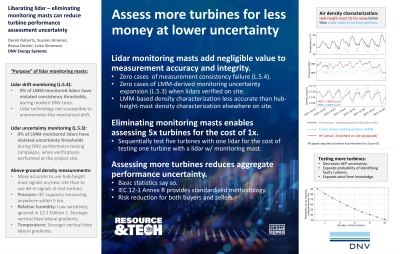Back

Liberating lidar – eliminating monitoring masts can reduce aggregate turbine performance test uncertainty
Tuesday, October 1, 2024
5:00 PM – 6:00 PM MST
Location: Regency D


Derek Roberts, PhD
Senior Performance Engineer
DNV
Sacramento, California
Poster Presenter(s)
Presentation Description: Ground-based lidar is a mobile and comparatively cheap wind-measurement platform for turbine power performance testing (PPT). In concept, these advantages should enable testing more turbines, yielding lower performance test uncertainty. In practice, efficient deployment of lidars for PPT is limited by the IEC 61400-12-1 requirement that lidars only be deployed with co-located lidar monitoring masts (LMMs).
Using data from more than 20 lidar-based PPTs, we show that wind speed information gleaned from co-located LMMs rarely, if ever, leads to an adjustment in test results or uncertainties. We present cases where lidar post-verification further confirmed lidar measurement consistency. Finally, we present results from a variety of cases where we assessed non-LMM alternatives to air density characterization, and show that LMMs offer little to no advantage relative to alternative measurement approaches.
Our data support the application of lidar for PPT without LMMs and without concomitant uncertainty increases. The elimination of LMM requirements would enable efficient lidar-based PPT campaigns that include more turbines. Turbine-supplier guarantees generally ignore sample-size effects in contractual definitions of aggregate test uncertainty, even though IEC guidance exists on the subject. Even if supplier guarantees continue to exclude sample-size considerations, the incorporation of basic statistical maxims into PPT provides a more comprehensive uncertainty assessment to all interested parties; no-LMM lidar-based measurements could readily increase PPT sample sizes and, therefore, decrease uncertainty in aggregate performance assessments.
Using data from more than 20 lidar-based PPTs, we show that wind speed information gleaned from co-located LMMs rarely, if ever, leads to an adjustment in test results or uncertainties. We present cases where lidar post-verification further confirmed lidar measurement consistency. Finally, we present results from a variety of cases where we assessed non-LMM alternatives to air density characterization, and show that LMMs offer little to no advantage relative to alternative measurement approaches.
Our data support the application of lidar for PPT without LMMs and without concomitant uncertainty increases. The elimination of LMM requirements would enable efficient lidar-based PPT campaigns that include more turbines. Turbine-supplier guarantees generally ignore sample-size effects in contractual definitions of aggregate test uncertainty, even though IEC guidance exists on the subject. Even if supplier guarantees continue to exclude sample-size considerations, the incorporation of basic statistical maxims into PPT provides a more comprehensive uncertainty assessment to all interested parties; no-LMM lidar-based measurements could readily increase PPT sample sizes and, therefore, decrease uncertainty in aggregate performance assessments.
